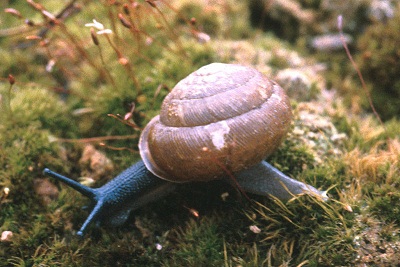
Classification
Domain: Eukaryota
Kingdom: Animalia
Phylum: Mollusca
Class: Gastropoda
Order: Stylommatophora
Family: Polygyridae
Genus: Patera
Species: Patera clarki nantahala
(Stang, 2012)
Domain Eukarya:
This domain consists of organisms with one or more cells that contain a nuclei and organelles (Saunders,
2007).
Kingdom Animalia:
This kingdom
consists of many-celled organisms and many single-celled organisms
that are different from plants (Animalia,
2007). They differ in a number of
ways, some being that they lack chlorophyll and require complex food
sources (Animalia, 2007). They
also have the characteristic of spontaneous movement and motor
response to stimulation (Animalia, 2007).
Phylum Mollusca:
This phylum includes a large group of organisms that differ in form
from other organisms. Mollusks are found almost everywhere and
can be found in other animals as parasites (Burch,
1962). Most mollusks have a hard external shell, a mantle,
mucous or slime glands, and a "foot" (Burch,
1962). This "foot" is used for crawling, digging, or
catching prey (Burch, 1962).
Snails eat a handful of things, their own species included (Burch,
1962).
Class Gastropoda:
This class consists of snails and slugs that have only one or no shell. They also have sensory organs on
their head (Burch, 1962). Gastropods
are described to be quite sluggish, mainly because they carry a
heavy shell (Hickman, 2011).
Class Gastropoda is separated into three subclasses;
Prosobranchiata, Opisthobranchiata, and
Pulmonata (Burch, 1962).
These three classes differ in the position of the respiratory
apparatus (Burch, 1962). In
Prosobranchiata, the breathing organ or gill in
gastropods is in front of the heart. In
Opisthobranchiata, the breathing organ is behind the heart
(Burch, 1962). And in
Pulmonata the breathing organs have been replaced by a
vascular lung that breathes either air or water depending on the
species habitat (Burch, 1962).
According to Burch, ospithobranchs live in marine environments while prosobranchs
and pulmonates also live in marine habitats as well as freshwater
habitats and on land.
Order Stylommatophora
Animals of this group have two pairs of tentacles with eyes on the
tips of the upper tentacles (Burch, 1962).
The Stylommatophora are separated into four suborders (Burch,
1962). The suborders are as follows; the Orthurethra, the
Mesurethra, the Heterurethra, and the Sigmurethra (Burch,
1962). According to Burch the Sigmurethra are the most
advanced and most important group in the U.S. They differ from
the other suborders because their ureter is reflexed from the apex
of the kidney (Burch, 1962).
Family Polygyridae:
Medium to large helicid snails with reflected lips (Burch,
1962). Polygyridae extends from Alaska to Canada and into
the tropics (Grimm et al., 2009).
Species of this family flourish in humid regions and are, for the
most part, woodland snails (Burch, 1962).
Genus Patera:
Snails that have shells 15-27mm in size, with colors of either tan
or brown (Grimm et al., 2009).
Snails in the genus Patera are air-breathing snails (Pilsbry,
1940). In latin Patera means "saucer" (Pilsbry,
1940). These snails were most likely named after the
"saucer" like shape of their shells (Pilsbry,
1940).
Species Patera clarki nantahala:
Also known as the Noonday Globe snail, Patera clarki nantahala
is land snail with a brownish to tan color shell (Fridell,
2011). "Nantahala"
in Cherokee means "noonday" (U.S.
Fish and Wildlife Service, 1978). Not much is known about the
Noonday Globe snail's reproductive behavior or diet (Fridell,
2011). However,
according to Fridell, other species related to Patera feed on hair like
structures of fungi. Noonday Globe snails are said
to be most active during moist and wet weather (Fridell,
2011).
Interested in where these little critters live?
Click the button below to find out!
